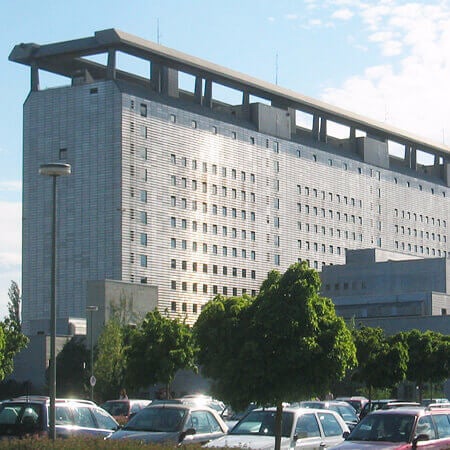Urethral stones (calculi) are dense formations resulting from inflammation, metabolic disorders, and changes in urine pH levels. A stone can get into the urethra from other organs in kidney stone disease or be formed on the spot. The pathology is rare. Children have this disease more often than adults, and men are more often affected than women. On the Booking Health website, you can find out the cost of treatment for urethral stones abroad and compare prices in different hospitals. Our employees will help you find a medical center and take care of all the arrangements for the trip.
Content
- What are the causes of stone development?
- Diagnostics
- Treatment options
- Endoscopic stone fragmentation methods
- Why to undergo your treatment abroad?
What are the causes of stone development?
Stones in the urethra usually develop due to the migration of stones from the bladder. They are fixed in a narrow site and do not enter the external environment during urination. The cases where stones initially form in the urethra are less common. This usually occurs due to concomitant diseases, for example, urethral strictures, fistulas, or diverticula.
Women have a wider urethra than men. As a result, stones usually pass through it normally, and secondary (from the bladder) calculi are uncommon in women. Women, however, sometimes have primary stones due to diverticula, while men are most often diagnosed with secondary stones.
More often than not, urethral stones are diagnosed in children under the age of 10, but adults under the age of 20 have them much less often. After 30 years, they are very rare.
Urethral stones mostly consist of calcium oxalate, as their proportion reaches 90%. Stones may be less commonly composed of struvite, calcium phosphate, or uric acid.
Diagnostics
Patients with urethral stones go to their doctor with the following complaints:
- weak urine stream;
- painful urination;
- acute urinary retention may occur;
- blood in the urine.
A urethral stone can be detected even during a clinical examination. It can be identified by palpation.
An X-ray scan, an ultrasound scan, or a CT scan can be conducted to clarify the location and size of the calculus. The value of computed tomography lies in determining the composition and density of the stone. Density determines which stone fragmentation methods doctors will use to extract it piece by piece.
Patients with secondary urethral stones often have calculi found in other parts of their urinary system. The pelvicalyceal system of the kidney is the most common site for their location, and the bladder is less often affected.
Patients with primary urethral stones frequently have urethral concomitant diseases, which should be diagnosed. Most often than not, these are diverticula, that is, mucous membrane protrusions in the form of a "sac", inside which a stone gradually grows. Without treatment, such calculi reach large sizes, up to 5 cm or more, while in a normal urethra, their size usually does not exceed 1-1.5 cm. During the diagnostics, doctors can also detect urethral strictures, or local narrowing, due to which the stone cannot go out into the environment.
Treatment options
A spontaneous discharge of the calculus is unlikely, so doctors usually do not use conservative treatment. The specialists remove the stone using an endoscopic procedure, while open surgery is a less common treatment option. Surgical removal may be required for large and immovable stones or concomitant diseases of the urinary tract.
The main methods of treatment are the following:
Lithoextraction. Doctors can remove small stones with forceps or a basket. This is a minimally invasive endourethral procedure. It does not require general anesthesia and has a minimal risk of complications.
External urethrotomy. This is a procedure that involves urethral dissection from the outside to extract the calculus.
Extraction through a urethrocutaneous fistula. This treatment option can be used in patients with urethral stones combined with a fistula, which is a through channel that opens to the surface of the skin.
Extracorporeal shock wave therapy. The method implies stone fragmentation with acoustic waves. The device is located outside the patient's body. The calculus cannot come out of the urethra on its own because it is too large. After fragmenting the stones, they come out naturally. The procedure is usually carried out to treat stones up to 2.5 cm in greatest dimension.
Although the method of treatment is non-invasive, it requires the insertion of a urethral catheter and the pushing of the stone into the bladder. In some cases, stone fragments may get stuck elsewhere, resulting in acute urinary retention. Doctors may then try to crush the stones again. In most cases, this attempt ends successfully. After the catheter is evacuated, the stones will be removed. When the desired effect cannot be achieved, the specialists may resort to endoscopic or surgical treatment.
Many patients seek medical attention for acute urinary retention. The stone clogs the lumen of the urethra, so urine accumulates in the bladder. In such a situation, a doctor may perform a suprapubic aspiration of the bladder (a puncture above the pubis) to divert urine. The procedure allows time for preparation and endoscopic stone removal.
Large stones may sometimes be formed in the prostatic urethra. They cannot be removed or pushed into the bladder. Such patients may require major open surgery through a transvesical approach for stone removal. The surgical procedure is performed through an abdominal incision. The intervention involves bladder dissection.
Surgeons abroad also perform laparoscopic surgery instead of traumatic open operations. In addition, some specialized centers perform the safest and most sparing robot-assisted interventions. They are carried out through several short incisions. The use of robotic technology reduces the risk of complications and shortens the rehabilitation period, but increases the cost of treatment.
Endoscopic stone fragmentation methods
Stones in the posterior urethra are more difficult to remove, especially if they are large and cannot be extracted from the urethra. In this case, their fragmentation is required. Stones are usually crushed not in the urethra but in the bladder, where they are pushed during the endoscopic procedure.
The main methods of stone fragmentation in urolithiasis are the following:
Mechanical lithotripsy. This treatment approach allows doctors to destroy stones of any density. The procedure cannot be used for urethral stone fragmentation due to the large size of the lithotripter. The device is only intended for use in the bladder. In addition, some types of lithotripters allow the extraction of stones and their fragments from diverticula.
Electrohydraulic lithotripsy. Although this method is the most reliable for high-density stones, it is practically not used in developed countries. If a doctor has managed to shift the stone from the urethra to the bladder, it is mobile. When using the electrohydraulic fragmentation method, a moving stone can injure the urethral and bladder mucous membranes.
Ultrasonic lithotripsy. The method uses ultrasonic waves to crush the stones. They cause the lithotripter to vibrate and destroy the stones. At the same time, a hollow probe can be used for washing to remove fragments. The technique is sparing, safe, and usually effective, but in the case of large and high-density stones, failures may occur.
Pneumatic lithotripsy. This is a relatively new technique that was first used in the 1990s of the twentieth century. The procedure provides for the crushing of stones of any size and density. Nonetheless, moving stones may injure the bladder, which limits the use of this method of lithotripsy. Doctors often combine the pneumatic fragmentation method with ultrasonic lithotripsy to treat multiple stones in the urinary system.
Laser lithotripsy. The laser heats and vaporizes the stone, thereby causing it to crack. The fluid inside the calculus quickly heats up and evaporates, causing a pressure drop. As a result, the stone breaks into fragments. The technique is effective for large stones of any density. It is compatible with the use of flexible endoscopes that do not injure the urethra.
Why to undergo your treatment abroad?
If you have stones in your urethra, it is best to undergo your treatment abroad. Doctors in developed countries use safe and sparing methods of stone fragmentation and extraction. They are minimally traumatic. Foreign urologists have extensive and successful experience in the treatment of urethra stones in patients of any age, including children.
There are a few reasons for you to undergo your treatment abroad. These are the following:
- accurate diagnostics will help to identify all the stones, determine their location, number, size, composition, density, and concomitant diseases;
- the use of safe endoscopic procedures instead of traumatic operations;
- successful treatment even in the case of complications or acute urinary retention;
- endourological methods can be used in both adults and children;
- a minimally invasive percutaneous procedure (suprapubic aspiration) may be performed instead of open bladder surgery;
- the use of the most advanced stone fragmentation methods, such as ultrasonic, laser, and pneumatic lithotripsy procedures;
- stones in the urethra, bladder, and kidneys can be treated simultaneously;
- doctors can conduct one-stage treatment of several urethral diseases, including fistulas, strictures, and diverticula.
- specialists strive to perform minimally invasive removal of even giant urethral stones without open surgery;
- specialized hospitals use laparoscopic and robot-assisted operations instead of the standard transvesical approach.
On the Booking Health website, you can find out the cost of treatment and choose a medical care program at the best price. We will select a hospital for you where doctors have extensive experience in the treatment of urethra stones, use modern methods of treatment, and achieve the best results. When you make an appointment through the Booking Health website, the cost of treatment will be lower than when you contact a hospital directly. The price will be reduced due to the absence of taxes for foreign patients. You will receive insurance against unexpected medical expenses. This means that the initial cost of treatment after the start of the program will not increase, even if you need additional procedures.
The specialists from the Booking Health company will provide you with services for organizing treatment abroad. We will contact the hospital, help prepare documents, and translate your medical records and preliminary diagnostic results. We will also book hotel and airline tickets for you. You will be able to receive medical care on the dates you prefer. Whenever required, we can arrange your urgent treatment abroad. Our employees will meet you at the airport of another country, take you to the hospital by car, and provide a return transfer after the completion of your program. You will have the chance to have consultations with your doctor within 3 months after the completion of your treatment.
Authors:
The article was edited by medical experts, board-certified doctors Dr. Sergey Pashchenko and Dr. Vadim Zhiliuk. For the treatment of the conditions referred to in the article, you must consult a doctor; the information in the article is not intended for self-medication!
Sources:
Verywell Health
Healthline
















